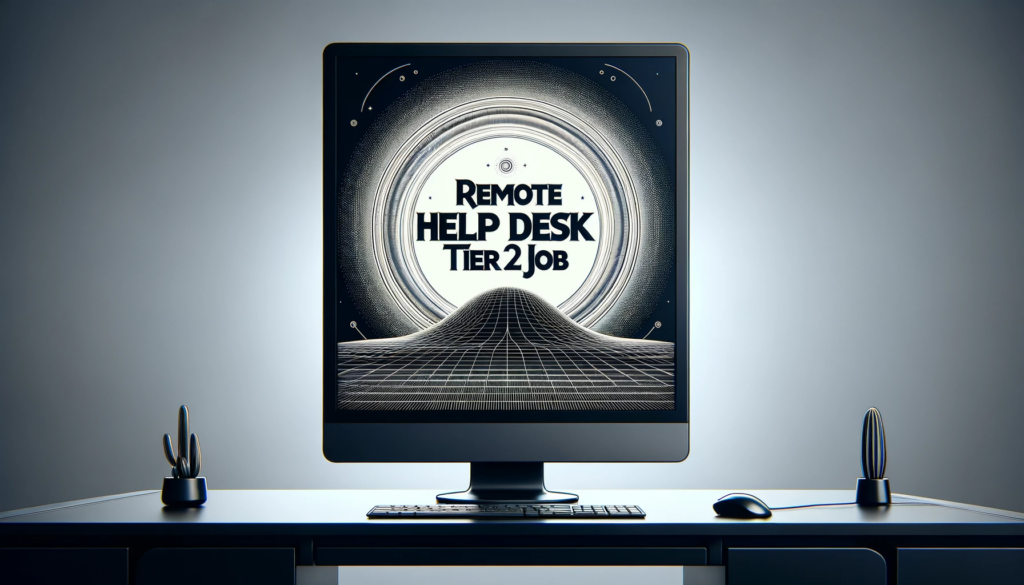The career of a remote help desk tier 2 technician is not just about addressing IT issues but also about adapting to the changing technological landscape, mastering remote communication and collaboration tools, and contributing proactively to the overall IT health of an organization. This evolution makes it an exciting and rewarding career path for those passionate about technology and customer service in the digital age.

1. Introduction to Remote Help Desk Tier 2 Job Careers
In the increasingly demanding environment of information technology, the concept of remote work has become increasingly prevalent, especially in the realm of help desk operations. A Remote Help Desk Tier 2 job career represents a significant segment in this evolution, offering a unique blend of challenges and opportunities for IT professionals. This career path is particularly relevant for Managed Service Providers (MSPs) who are constantly seeking efficient, skilled, and cost-effective solutions for their help desk needs.
1.1 The Evolving Role of Help Desk Technicians in a Digital World
The role of help desk technicians has undergone a substantial transformation. Traditionally, these professionals were the first line of support, handling basic customer queries and issues. However, with the advent of remote work and the increasing complexity of IT systems, the scope of their responsibilities and expertise required has expanded significantly.
Tier 2 help desk technicians, especially in a remote setup, are now expected to tackle more complex technical issues that Tier 1 technicians or Dispatchers escalate. These issues often require a deeper understanding of specific technologies, networks, and software. The digital world demands these technicians not only to be problem solvers but also to be adept at managing remote tools and communication channels effectively. They need to provide solutions promptly, often working across different time zones.
Moreover, the role has evolved to include a proactive approach to IT support. Remote Tier 2 technicians are often involved in monitoring systems, identifying potential issues before they become critical, and suggesting improvements to prevent future problems. This shift from a reactive to a proactive stance is a key aspect of their evolving role in the digital world.
2. The Daily Life of a Remote Help Desk Tier 2 Technician Job
The daily routine of a Remote Help Desk Tier 2 Technician is both challenging and varied, reflecting the dynamic nature of IT support in a remote environment. These professionals are the backbone of efficient IT operations, ensuring that more complex issues that surpass Tier 1 capabilities are resolved promptly and effectively.
Here’s a more focused list based on the detailed roles and responsibilities:
Investigating and Resolving Network Issues: Identifying and fixing network connectivity problems, configuring routers and switches, and ensuring secure and efficient network operations.
Software Troubleshooting and Support: Diagnosing software application errors, providing solutions to complex software issues, and coordinating with software vendors for the resolution of critical bugs.
Managing User Accounts and Permissions: Setting up and managing user accounts, including permissions and security settings, to ensure appropriate access controls are maintained.
Performing System Backups and Recovery: Executing regular backup procedures and conducting data recovery operations as needed to prevent data loss and ensure business continuity.
Updating and Patching Systems: Applying updates and patches to operating systems and applications to ensure security and functionality are up-to-date.
Monitoring and Enhancing IT Security Measures: Implementing and monitoring cybersecurity protocols, responding to security alerts, and conducting vulnerability assessments.
Providing Detailed Technical Advice and Guidance: Offering in-depth technical support and guidance to both end-users and Tier 1 support staff to resolve complex issues. This is great mentoring.
Diagnostics and Coordination: Remotely diagnosing software issues, and guiding users through basic troubleshooting steps.
Documenting Support Activities and Solutions: Keeping detailed records of support activities, solutions provided, and outstanding issues in a help desk management system. Keeping audits of nay updates or changes.
Collaborating with IT Teams on Projects: Working on IT projects, such as system upgrades or deployments, in collaboration with other IT teams and specialists.
Participating in Knowledge Sharing and Training Sessions: Sharing expertise with colleagues through knowledge base contributions, training sessions, or informal discussions to improve team capabilities.
Continuous Learning and Skill Enhancement: Engaging in self-directed learning, attending webinars, and pursuing certifications to stay current with the latest technologies and best practices.
This list encapsulates the varied and dynamic nature of a Remote Help Desk Tier 2 Technician’s day, highlighting the blend of technical, administrative, and collaborative tasks that define their role.
2.1 Tackling Advanced Technical Issues
A significant part of a Tier 2 technician’s day is dedicated to addressing advanced technical issues. These issues often require a deeper understanding of network infrastructures, software intricacies, and hardware complexities. Unlike Tier 1 technicians who handle basic queries, Tier 2 technicians delve into problem-solving that may involve debugging software, configuring networks, and resolving security breaches. They often work on issues that are not only more complex but also more critical to the operational integrity of the client’s IT infrastructure.
2.2 Collaboration and Continuous Learning
Collaboration is key in a remote setting. Tier 2 technicians frequently collaborate with other IT specialists, including Tier 1 technicians, network engineers, and cybersecurity experts, to resolve issues. This collaboration often happens through digital communication tools like video conferencing, chat applications, and collaborative online platforms.
Continuous learning is another crucial aspect of their daily life. The IT field is constantly evolving, and staying abreast of the latest technologies, trends, and best practices is essential. This might involve participating in online training sessions, attending webinars, or obtaining certifications in specific IT domains. This ongoing education ensures that they can not only solve current problems but also anticipate and mitigate future issues.
3. Key Skills and Qualifications for Success
Technical proficiency and problem-solving skills along with great communication and adaptability make for an excellent remote helpdesk technician.

3.1 Technical Proficiency and Problem-Solving
Essential technical skills such as advanced troubleshooting, network management, and security protocols will be discussed here. Using an example, it will liken these skills to a toolkit that a technician must constantly update and maintain.
3.2 Communication and Adaptability in a Remote Setting
The importance of strong communication skills and adaptability in a remote environment will be emphasized. For instance, it can be compared to being a good remote pilot, where understanding and conveying complex information clearly is crucial for smooth operations.
4. Benefits of Remote Work for Tier 2 Technicians
Remote work offers several advantages for Tier 2 Technicians, significantly impacting their job satisfaction and efficiency. For MSPs and other businesses needing help desk support, it means a wider talent pool with increased cost-efficiency and client satisfaction.
4.1 Enhanced Work-Life Balance
One of the most significant benefits is the enhanced work-life balance. Remote work eliminates commuting time, allowing technicians more flexibility to manage their personal and professional lives. This flexibility can lead to reduced stress, increased job satisfaction, and higher productivity, as employees can work in environments where they feel most comfortable and efficient.
4.2 Access to a Global Talent Pool and Diverse Perspectives
Remote work opens up opportunities for technicians to be part of a global workforce. This exposure to a diverse talent pool brings in varied perspectives and innovative approaches to problem-solving. It also allows technicians to collaborate with peers from different cultures and backgrounds, enriching their professional experience and fostering a more inclusive work environment.
5. Challenges and Solutions in Remote Help Desk Roles
While remote work offers many benefits, it also presents unique challenges that need to be addressed and overcome.
5.1 Overcoming Isolation and Communication Barriers
Remote Tier 2 technicians may sometimes feel isolated due to the lack of physical interaction with colleagues. Overcoming this requires intentional efforts to stay connected, such as regular virtual team meetings and social interactions. Effective use of communication tools can also help bridge the gap, ensuring clear and consistent communication.
5.2 Maintaining Discipline and Productivity
Maintaining discipline and productivity in a remote environment can be challenging. It’s important for technicians to establish a dedicated workspace, adhere to a structured schedule, and use productivity tools to stay on track. Employers can support this by providing resources and training on time management and self-discipline.
6. Career Growth and Development Opportunities for Remote Helpdesk Technicians
The career trajectory for Remote Help Desk Tier 2 Technicians is promising, with various avenues for growth and development.

6.1 Pathways to Advanced Technical Roles
Tier 2 technicians have the opportunity to advance to more specialized technical roles. This could involve deepening expertise in specific areas like cybersecurity, network architecture, or cloud services. Continuous learning and upskilling are key to progressing along this path.
6.2 Leadership and Management Opportunities
There are also opportunities for moving into leadership and management roles. Technicians can evolve into team leads, supervisors, or managers, overseeing help desk operations and mentoring junior staff. This requires not only technical expertise but also strong leadership and people management skills.
Advancing to a Tier 3 technical position offers these 2 paths as the main choices aspiring technicians can make. If you are an experienced technician who wants to work in the MSP help desk remotely, apply to work with Support Adventure!
7. How MSP Staff Outsourcing Enhances Remote Work Efficiency
MSP Staff Outsourcing plays a crucial role in optimizing the efficiency of remote help desk operations. With seamless integration, exceptional after-hours service, and charismatic technicians it’s a helpdesk addition that will improve any business.
7.1 Providing Vetted, Skilled Professionals
These companies specialize in providing highly vetted, skilled professionals who are a good fit for the specific needs of an MSP. This ensures that the staff brought on board are not only technically proficient but also quick to adapt to the MSP’s specific systems and processes. With Recruitment Process Outsourcing (RPO) and Selection Process Outsourcing (SPO), these companies can cut the cost and hassle associated with attracting, interviewing, and hiring excellent staff.
7.2 Cultural Compatibility and Seamless Integration
MSP Staffing Companies also focus on cultural compatibility, ensuring that the professionals they provide can seamlessly integrate into the existing team. This is crucial for maintaining a cohesive work environment, especially in a remote setting where cultural nuances can significantly impact team dynamics.
7.3 Outsourced Staff Management
A proficient staff outsourcing company, such as Support Adventure, plays a pivotal role in streamlining the complexities associated with managing outsourced staff, especially in remote settings. These companies take a comprehensive approach to staff management, ensuring that the MSPs they serve can focus on their core operations while the outsourced team operates efficiently and effectively.
Here’s how a good staff outsourcing company manages various aspects of outsourced staff management:
Recruitment and Onboarding: The process begins with the meticulous selection of candidates who not only possess the necessary technical skills but also align with the MSP’s cultural and operational ethos. Following selection, a structured onboarding process ensures that these individuals are well-acquainted with the MSP’s systems, processes, and expectations, facilitating a smooth integration into the team.
Time Management and Scheduling: Effective time management is crucial in remote work environments to ensure that operations run smoothly across different time zones. Outsourcing companies utilize sophisticated scheduling tools and strategies to manage shifts, cover peak times, and ensure that help desk support is available 24/7, if necessary. This includes managing time-off requests and ensuring that there is always adequate coverage.
Performance Monitoring and Quality Assurance: Through regular performance reviews and monitoring, outsourcing companies ensure that the staff meets the high standards expected by MSPs. This involves setting clear performance metrics, conducting regular check-ins, and using quality assurance measures to maintain high levels of service delivery. Feedback mechanisms are also put in place to encourage continuous improvement.
Training and Professional Development: Recognizing the fast-paced nature of the IT industry, these companies invest in ongoing training and professional development for their staff. This ensures that the team remains proficient in the latest technologies and best practices, thereby adding value to the MSPs they support.
Payment and Benefits Administration: Outsourcing companies manage all aspects of compensation, including timely payment of salaries, administration of benefits, and ensuring compliance with local labor laws. This relieves MSPs from the administrative burden associated with managing a global workforce.
Compliance and Legalities: Navigating the legal complexities of employing remote staff in different jurisdictions can be challenging. Staff outsourcing companies take on this responsibility, ensuring compliance with employment laws, tax regulations, and data protection standards in the regions they operate. This mitigates legal risks for MSPs and ensures a hassle-free operation.
Conflict Resolution and Support: They also provide a support system for both the outsourced staff and the MSP, acting as a mediator to resolve any conflicts or issues that may arise. This includes addressing concerns related to work conditions, interpersonal conflicts, or performance issues, and ensuring that resolutions are found promptly and amicably.
8. Conclusion and Future Outlook of Remote Help Desk Tier 2 Jobs
This overview highlights the dynamic and promising nature of a career in remote help desk support, particularly at the Tier 2 level, and the crucial role MSP Staffing Companies play in this ecosystem.

8.1 Summarizing the Remote Tier 2 Help Desk Job Career Landscape
The role of a Remote Help Desk Tier 2 Technician is multifaceted and evolving. It offers a balance of technical challenges, opportunities for growth, and the benefits of remote work, while also requiring adaptability and continuous learning.
8.2 Anticipating Future Trends and Developments
Looking ahead, the demand for skilled remote help desk professionals is likely to grow as more organizations embrace remote work. Technological advancements and the increasing complexity of IT environments will continue to shape the role of these professionals. Staying ahead of trends, upskilling, and adapting to new technologies will be key for those looking to thrive in this field.
Sources for Case Studies and Reports:
- Gartner: Gartner is a leading research and advisory company that provides insights, advice, and tools for IT, HR, and business leaders. Gartner’s reports often cover trends in remote work, IT staffing, and the future of work. They periodically release studies that analyze shifts in the workforce, including the demand for IT professionals in remote settings.
- Forrester Research: Forrester offers a variety of reports and market insights that touch on remote work trends, technology adoption, and the future of IT jobs. Their research can provide evidence of how companies are adapting to remote work and the impact on IT support roles.
- LinkedIn’s Workforce Reports on Successful Outsourcing: LinkedIn publishes workforce reports that analyze trends in various industries, including IT. These reports can offer insights into hiring trends, in-demand skills, and the growth of remote work opportunities across the globe.
- McKinsey & Company: McKinsey’s research on the future of work often includes insights into how organizations are transforming their operations to accommodate remote work and what that means for IT support and help desk roles.
- IDC (International Data Corporation): IDC provides market intelligence, advisory services, and events for the information technology, telecommunications, and consumer technology markets. Their reports and analyses can offer data on the growth of remote work and its implications for IT staffing.
If you’re an MSP looking to hire top-tier staff remotely for your helpdesk, reach out to us!



0 Comments